June 16 (Saturday) – September 2 (Sunday), 2018
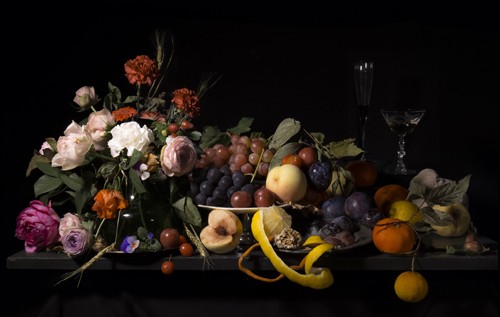
Banquet, 2018 giclee print ©Mami Kosemura
Exhibition Outline
This summer, the Hara Museum of Contemporary Art is happy to present Mami Kosemura: Phantasies Over Time, the first solo museum show of an artist who blurs the boundary between painting, video and photography to explore the nature of reality. For this exhibition, Kosemura will introduce about 30 pieces ranging from early animations to her most recent photographic and video installations, many of which incorporate her signature motifs–the stillness of painting and the movement of film. These can be seen in her early work for which she used time-lapse photography*1 to capture images over several months. By manually altering thousands of frames and linking them together, she created “animated still-lifes” of fruit, flowers and other objects composed in the style of a 17th century Spanish still-life painting. She continued to mimic Spanish still-life painting in later work made in New York City, taking as her subject matter junk and other detritus collected from the city streets. In one of her newest creations featured in the exhibition, she used time-lapse photography to document the gradual evolution of a work from beginning to end, offering a glimpse not only into the nature of painting, but into her creative process as well. In her treatment of space, time and movement, Kosemura invites the viewer to think in new and different ways about the fictional and the real.
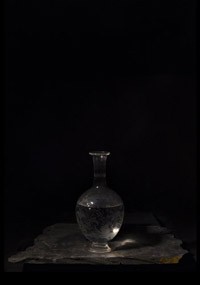
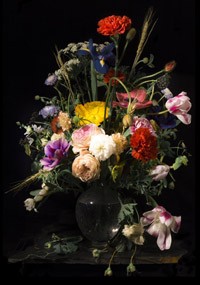
Guise, 2018 giclee print (set of seven) ©Mami Kosemura
Background to the Art of Mami Kosemura
In recent years, realism has seen a surge in popularity in Japan. Exhibitions of realistic painting abound and the demand for such art, even by artists with slim resumes, often exceeds the supply. The appeal of realistic art is understandable. It is hard to deny the awe engendered by a work of photographic realism and the skill required to produce it.
Realism is an obvious aspect of Mami Kosemura’s work. Since the beginning of her career, her connection with realism has been deep. For the artist, however, realism is not merely a goal, it is a theme. Her images are not merely imitations, they are explorations. For example, Decaying (2001), a work from early in her career, imitates a Caravaggesque*2 still-life painting, clearly imitates the still-life painting and Sweet Scent (2003) clearly imitates the still-life painting of Francisco de Zurbarán (1598-1664). Kosemura, however, uses imitation in these images not to draw attention to the realistic depiction of texture and space, i.e., the intent of the originals, but to create a setting that focuses attention on the nature of still-life painting itself, to reproduce in the setting the essential qualities of a still-life painting and then to sabotage those qualities in order to expose the painting’s gap with reality, to make visible the fiction behind the painting itself.
Only by returning a painted scene to its real setting and three-dimensional space can we understand how far the depicted reality has departed from everyday reality. Only then do we see it as a “deformed” and “altered” version of everyday reality that has become strange and peculiar.*3
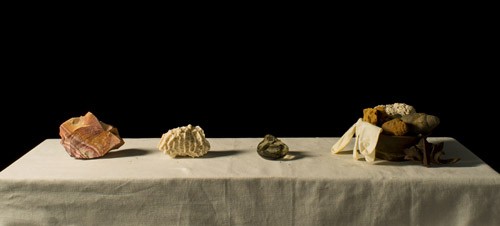
Objects – New York III, 2016 giclee print ©Mami Kosemura
What is intriguing is that after revealing the fictional in a painting, Kosemura goes on to recapture a sense of reality by introducing movement in the same painting. For the artist, her “painting” is actually an animation composed of thousands of images that she has retouched by hand. In these works, a powerful sense of “life” is conveyed by the phenomenon of movement. This peculiar phenomenon through which fiction becomes reality is what the artwork is all about.
Regardless of how strange or peculiar a scene has become, the moment the scene moves, we are instantly given a glimpse of the scene’s “raw reality.” Time and movement provide a means by which a normal scene that has been deformed or altered, i.e., a scene in a painting, can attempt a return to its original normality. *4
In making her “still-life movies,” Kosemura has uncovered new possibilities through the merging of painting, photography and video, melding each new discovery into a new work of art. In this way, she has gone on to explore new areas of inquiry, such as temporal and spatial structures among different media, the idea of surface in images, and material and tactile characteristics in video.
What is captivating about Kosemura’s works clearly lies in the intellectual nature of her pursuit. Another element of that attraction may also be the unique, normally unperceived world that is revealed through time-lapse photography, a world referred to by Walter Benjamin as a “space informed by the unconscious.*5 We see this in the movie entitled Decaying. Here, an arrangement of cut flowers withers, as we expect it to, with the passage of time, but then, suddenly and unexpectedly, begins to bloom again with great vigor.
No matter how theatrical or fictional a setting might be, to shoot a video or photograph of it is to expose reality. My task, I believe, is to merely arrange a setting to allow that unpredictable reality to be seen with wonder. If reality is intrinsically ambiguous, then perhaps it is within that ambiguity that important things lie hidden?*6
These past explorations seem to have led Kosemura to her latest works, such as Pendulum (2016) and Objects – New York – (2016), which embrace image distortions and objects of unknown meaning (elements which Kosemura refers to as “errors”) and whose interpretation is left up to the viewer. Kosemura’s work, which began with her Caravaggesque still-lifes, continues to swing back and forth like a pendulum between painting, photography and video, creating situations that reveal realities heretofore invisible to viewers, including the artist herself, situations in which unpredictable realities occur. Whether a picture is a fashionable realistic painting or not, what motivates artists to continue creating may very well be the urge to see such invisible realities.
This exhibition also serves as a showcase for work made by Kosemura during a period of overseas study provided by the Gotoh Cultural Award, and is being partially funded by the Hara Museum Corporate Supporting Membership which includes in its mission support for artists.
Notes:
1. Time-lapse shooting refers to the taking of consecutive pictures at fixed time intervals.
2. A term that describes the work by 17-century Spanish and Dutch painters strongly influenced by the Italian painter Michelangelo Merisi Caravaggio (1571-1610) and his use of realism and dramatic lighting (known as chiaroscruo).
3. Artist statement, Toride Art Project, 2006, http://www.toride-ap.gr.jp/sg/past/2/kosemura-1.html.
4. Ibid.
5. Walter Benjamin, Little History of Photography (translated by Edmund Jephcott and Kingsley Shorter), 1995.
6. From an interview conducted with the artist.
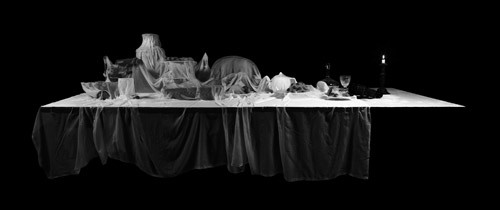
Drape, 2014 giclee print ©Mami Kosemura
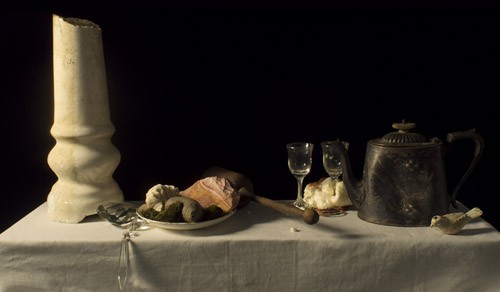
Objects – New York, 2016 giclee print ©Mami Kosemura
Theme by Gallery
Gallery I
Room of Beginnings and Endings
Drawings and the beginning or end of various works (initial impetuses or debris)
Gallery II
Room of Western Paintings
Gallery III
Room of Human figure
episode III, the sound of breathing
Gallery IV
New York Room
Extensions from painting and rough experiments
Gallery V
Room of Black Still-lifes
Heading towards the end, from moving image to still image
Artist Profile
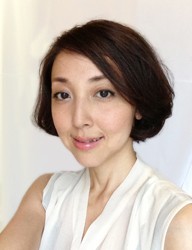
Mami Kosemura was born in 1975 in Kanagawa prefecture where she still resides. In 2005, she graduated from the Tokyo National University of the Arts with a D.A. in painting. In addition to solo exhibitions at galleries in Japan and abroad, she has participated in many group exhibitions. In Japan, these include the MOT Annual 2004 -Where do I come from? Where am I going? (Museum of Contemporary Art, Tokyo), NIHONGA Painting: Six Provocative Artists (Yokohama Museum of Art, 2006) and SELF and OTHER: Portrait from Asia and Europe (National Museum of Art, Osaka, Museum of Modern Art, Kamakura & Hayama, 2009). Overseas exhibitions include Projected Realities: Video Art from East Asia (Asia Society Museum, New York, 2006), East of Eden (The Freer Gallery of Art and the Arthur M. Sackler Gallery, Washington DC, 2007), International Incheon Women Artists’ Biennale (Incheon, Korea, 2009), Mind as Passion (Taipei City Museum of Art, 2009), Now Japan (Kunsthal KAdE, Netherlands, 2013), and 2014 Kuandu Biennale 2014 (Taipei). Kosemura has been extending the range of her activities to include, for example, a collaboration with composers at Carnegie Hall for a 150th anniversary event in New York in 2017.
Major awards received by the artist include the Kume Award (1996), Takahashi Arts Foundation Award (2001), Nomura Award from the Nomura Arts and Culture Foundation (2004) and the 26nd Gotoh Cultural Award of the Gotoh Memorial Foundation (2015). Kosemura’s art is included in the collections of the Museum of Contemporary Art, Tokyo, The University Art Museum of Tokyo University of the Arts, Gunma Museum of Art, Tatebayashi, Asia Society Museum (New York) and Kuandu Museum of Fine Arts (Taipei).
The Gotoh Memorial Foundation and the Gotoh Cultural Award
The Gotoh Memorial Foundation was founded in March 1990 in commemoration of the distinguished achievements of the late Mr. Noboru Gotoh, former Chairman of Tokyu Corporation, who was committed to creating a comfortable and affluent living environment. In order to achieve this goal, the Gotoh Cultural Award is presented by the Foundation each year to the most promising and talented young artists selected in the areas of fine arts and opera. This award includes financial support to study abroad and to show the fruits of their study after returning to Japan.
Exhibition Details
Title: Mami Kosemura: Phantasies Over Time
Dates: June 16 (Saturday) – September 2 (Sunday), 2018
Venue/Organizer: Hara Museum of Contemporary Art
4-7-25 Kitashinagawa, Shinagawa-ku, Tokyo 140-0001 Tel: 03-3445-0651
E-mail: info@haramuseum.or.jp Website: http://www.haramuseum.or.jp
Mobile site: http://mobile.haramuseum.or.jp Blog: https://www.art-it.asia/en/u/HaraMuseum_e
Twitter: http://twitter.com/haramuseum (in Japanese only / account name: @haramuseum)
Grant support provided by: The Gotoh Memorial Foundation
Supported by: Hara Museum Supporting Members
Hours: 11:00 am – 5:00 pm, Wednesdays until 8:00 pm (5:00 pm if a national holiday)(last entry 30 minutes before closing)
Closed: Mondays (except July 16), July 17
Admission: General 1,100 yen; Students 700 yen (high school and university) or 500 yen (elementary and junior high); 550 yen for people aged 70 or over; Free for Hara Museum members and for students through high school every Saturday during the school term; 100 yen discount per person for groups of 20 or more
Directions to the museum: 5 minutes by taxi or 15 minutes on foot from JR Shinagawa Station (Takanawa exit); or from the same station take the No.96 bus, get off at the first stop (Gotenyama), and walk 3 minutes
* An artist talk and a screening of unshown works are among the events scheduled to be held. Details will be posted on the Hara Museum website at a later date.
* A free Japanese-language tour will be given by a museum curator every Sunday and national holiday. The tour starts at 2:30 and lasts about 30 minutes. No reservation is required. Free mini-tours in English are also available on a periodic basis. Please enquire at the admission counter on the day of your visit.
* An exhibition catalogue is scheduled to be published in early June (B5 size, about 30 pages, price TBA).
Related Events
Venue: The Hall at the Hara Museum of Contemporary Art
Fee: Free (museum admission is required)
Meet the Artist: Mami Kosemura
July 7 (Saturday), 2018 14:30 – 16:00
For reservations: Please send an email to event@haramuseum.or.jp with your name, contact number and number of accompanying persons. The talk will be given in Japanese.
*Reservations accepted from June 19 (Tuesday).
Screening Every Wednesday Evening
July 11 until August 29 (each Wednesday)
Starts at 17:00 / Ends at 20:00
“Frozen – screening version -” 21 min. 20 sec., color, stereo sound
“Under Water” 14 min. 20 sec., color, stereo sound
“The Hotel That Time Forgot / Pendulum” 12 min., color, stereo sound
*The films will be screened in a loop.
*Viewers may enter The Hall at any time during the screening period.
Music at Hara Museum
akiko x masaki hayashi live at Hara Museum
July 12 (Thursday) 19:00 (museum door opens at 18:00)
4,500 yen includes museum admission (3,500 yen for Hara Museum Members)
Performing Art of Yann Tomita at Hara Museum
August 25 (Saturday) and 26 (Sunday) 17: 45 – (museum door opens at 17:15)
4,500 yen includes museum admission (4,000 yen for Hara Museum members)
*Reservations accepted from June 30 (Saturday).
Cafe d’Art Image Cake Information
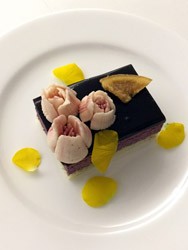
At the Cafe d’Art at the Hara Museum, visitors can enjoy a variety of seasonal dishes and desserts plus wine and champagne, along with a view of the artworks in the verdant courtyard garden. Those visiting the cafe will be happy to find our newest Image Cake (755 yen), the theme of which is the current exhibition Mami Kosemura: Phantasies Over Time. The Image Cake this time consists of a blueberry mousse topped by blueberry icing with butter cream flowers, dry orange slice and edible yellow flowers.
*Please note that the museum admission fee is required for those visiting the cafe only.
